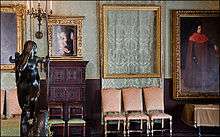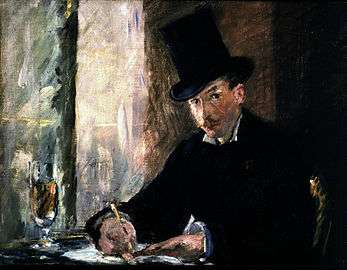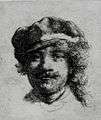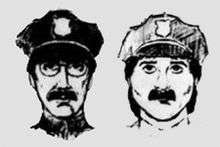Isabella Stewart Gardner Museum theft

In the early hours of March 18, 1990, security guards at the Isabella Stewart Gardner Museum in Boston, Massachusetts, let in two men disguised as police officers who claimed they were responding to a disturbance call. Once inside, the pair revealed their true intentions, tied up the guards, and spent over an hour stealing art from the museum's collection, which they loaded into their vehicle. It was found that they had taken 13 works of art, valued at $500 million, making it the largest private property theft in history. Despite efforts by the Federal Bureau of Investigation (FBI) and multiple probes across the world, no arrests have been made and no artwork has yet been recovered. The case remains open and unsolved, with the museum offering a reward of $5 million for information leading to recovery of the art.
The stolen works were originally purchased by art collector Isabella Stewart Gardner (1840–1924) and intended to be left on permanent display at the museum with the rest of her collection. Since the collection and its layout are permanent, empty frames remain hanging both in homage to the missing works and as placeholders for when they are returned. Experts are puzzled by the choice of paintings that were stolen, especially since more valuable artwork was untouched. Among the stolen works was The Concert, one of only 34 known works by Vermeer and thought to be the most valuable unrecovered painting at over $200 million. Also missing is The Storm on the Sea of Galilee, Rembrandt's only known seascape. Other works by Rembrandt, Degas, Manet, and Flinck were also stolen.
According to the FBI, the stolen artwork was moved through the region and offered for sale in Philadelphia during the early 2000s. They believe the thieves were members of a criminal organization based in the mid-Atlantic and New England. They also claim to have identified two suspects, although they have not been publicly identified and are now deceased. Boston gangster Bobby Donati, murdered in 1991 as a result of ongoing gang wars, has been cited as a possible collaborator in the heist. Significant evidence suggests that Hartford, Connecticut, gangster Robert Gentile knows the location of the works, although he denies involvement.
Robbery
Around midnight on Sunday morning, March 18, 1990, a red Dodge Daytona pulled up near the side entrance of the Isabella Stewart Gardner Museum along Palace Road.[1][2] Two men with fake police uniforms waited for at least an hour in the car, possibly trying to avoid being noticed by people leaving a St. Patrick's Day party nearby.[3] Later at around 1 a.m., security guard Richard Abath returned to the front desk after patrolling the museum to switch positions with the other security guard. The two guards were the only people in the building. At this time, Abath opened and quickly shut the Palace Road door, claiming he was trained to do this to ensure the door was locked. He claimed security logs from other nights would show that he had done this many times previously. The FBI has seized the logs, but has not commented on the issue further.[3]
At 1:24 a.m., one of the two men outside pushed the buzzer near the door and told Abath they were policemen that heard of a disturbance in the courtyard, and requested to be let inside. Abath knew he should not let uninvited guests inside, but he was unsure on whether the rule applied to police officers. He could see the men and believed them to be police officers based on their uniforms. With his partner on patrol, Abath decided to buzz in the men.[3] When the intruders arrived at the main security desk, one of them told Abath that he looked familiar and there was a default warrant out for his arrest. Abath stepped out from behind his desk, where the only alarm button to alert police could be accessed. He was quickly asked for his ID, ordered to face the wall, and then handcuffed. Abath believed the arrest was a misunderstanding, until he realized he hadn't been frisked before being cuffed, and one officer's mustache was made of wax.[3] The second security guard arrived minutes later and was also handcuffed, after which he asked the intruders why he was being arrested. The thieves explained that they were not being arrested, but rather this was a robbery, and proceeded to take the guards to the museum's basement. They handcuffed the guards to pipes and wrapped duct tape around their hands, feet, and heads.[4]
Since the museum was equipped with motion detectors, the thieves' movements throughout the museum were recorded. After tying up the guards, the thieves went upstairs to the Dutch Room. As one of them approached Rembrandt's Self-Portrait (1629), a local alarm sounded, which they immediately smashed. They pulled the painting off the wall and attempted to take the wooden panel out of its heavy frame. Unsuccessful at the attempt, they left the painting on the floor. They cut Rembrandt's The Storm on the Sea of Galilee out of the frame, as well as A Lady and Gentleman in Black. They also removed Vermeer's The Concert and Govaert Flinck's Landscape with an Obelisk from their frames. Additionally, they also took a Chinese bronze gu from the Shang Dynasty.[4]
Elsewhere in the museum, they stole five Degas drawings and an eagle finial. The finial lay at the top of a Napoleonic flag, which they attempted to unscrew from the wall, but failed.[5] Manet's Chez Tortoni was also stolen from its location in the Blue Room. Motion detector records show that the only footsteps detected in the Blue Room that night were at 12:27 a.m. and again at 12:53 a.m. These times match to when Abath said he passed through on patrol. The frame for the painting was found on security chief Lyle W. Grindle's chair near the front desk.[3] The thieves made two trips to their car with artwork during the theft, which lasted 81 minutes. Before leaving, they visited the guards once more, telling them "You’ll be hearing from us in about a year," although they were never heard from again.[1] The guards remained handcuffed until police arrived at 8:15 a.m. later that morning.[4]
Stolen artwork
Altogether, thirteen pieces were stolen at an estimated loss of $500 million, making the robbery the largest private property theft in history.[6] Empty frames remain hanging in the museum, both in homage to the missing works and as placeholders for when they are returned.[7] One of the paintings, The Concert, was Gardner's first major acquisition and one of only 34 known Vermeer works in the world.[8] It is thought to be the most valuable unrecovered stolen painting, with a value estimated at over $200 million.[9] Another painting, The Storm on the Sea of Galilee, is Rembrandt's only known seascape.[1] The bronze finial was taken from the top of a Napoleonic flag, possibly appearing like gold to the thieves.[8] The museum is offering a $100,000 reward for this piece alone.[10]
The museum stresses that the paintings be kept in good condition by whoever has them. Museum director, Anne Hawley has stated that the works should be kept in a stable environment of 50% humidity and 70 °F. Additionally, they should be kept away from light and stored in acid-free paper. Hawley also noted to avoid rolling the paintings, which will crack the paint. If these guidelines are not followed, the paintings could be damaged and drop in value. More repainting would need to be done too, which hurts the paintings' integrity.[1]
The following are the thirteen stolen works, all of which are still missing.[5][8][11]






 Cortege aux Environs de Florence
Cortege aux Environs de Florence
by Degas
(c. 1857–1860) Program for an Artistic Soirée 1
Program for an Artistic Soirée 1
by Degas
(1884) Program for an Artistic Soirée 2
Program for an Artistic Soirée 2
by Degas
(1884) Three Mounted Jockeys
Three Mounted Jockeys
by Degas
(c. 1885–1888)
 A bronze eagle finial
A bronze eagle finial
(c. 1813–1814)
- Notes
- ↑ The museum believes A Lady and Gentleman in Black to be a Rembrandt; however some scholars, including the Rembrandt Research Project in Amsterdam, say it is not.[4]
- ↑ Landscape with an Obelisk was formerly attributed to Rembrandt until being associated with his pupil, Flinck.[12]
- ↑ This Self-Portrait is postage-stamp sized. Not to be confused with Rembrandt's Self-Portrait (1629) oil painting also at the museum, which the thieves attempted to steal but did not take.[4]
- ↑ The gu is dated during the Shang Dynasty
Investigation
The Federal Bureau of Investigation took control of the case on the grounds that the artwork could likely cross state lines.[13] They have conducted hundreds of interviews with probes stretching across the world involving Scotland Yard, Japanese and French authorities, private investigators, museum directors, and art dealers.[1] The FBI believes the thieves were members of a criminal organization based in the mid-Atlantic and New England, and that the stolen paintings were moved through Connecticut and the Philadelphia area in the years following the theft. Some of the art may have been offered for sale in Philadelphia in the early 2000s, including The Storm on the Sea of Galilee; however, their knowledge of what happened to the works after the attempted sale is limited.[2][14][15] The FBI stated it believed to know the identity of the thieves in 2013, but in 2015 announced that they were now deceased. They have declined to identify the individuals.[16]

No single motive or pattern has emerged through the thousands of pages of evidence gathered.[1] The selection of works puzzles the experts, specifically since more valuable artworks were available.[7] The FBI's lead agent assigned to the case, Geoffrey J. Kelly, finds it difficult to understand why this assortment of items was stolen despite the thieves being in the museum for enough time to take whatever they wished. On their way to the finial, the thieves passed by two Raphaels and a Botticelli painting.[4] Titian's The Rape of Europa, which is one of the museum's most well-known and valuable pieces, was not stolen.[4] Due to the brutish ways the criminals handled the robbery, cutting the painting from their frames and smashing frames for two Degas sketches, investigators believe the thieves were amateur criminals, not experts commissioned to steal particular works.[3] Some investigators believe the works were destroyed, explaining why they have not reappeared.[1] Theories on the theft include that it was organized by the Irish Republican Army in order to raise money or bargain for the release of imprisoned comrades. Another theory states Whitey Bulger as the ringleader of the theft. At the time of the heist, he was Boston's top crime boss and an FBI informant.[1]
The museum first offered a reward of $1 million, but that was later increased to $5 million in 1997.[1] The reward is for "information that leads directly to the recovery of all of [their] items in good condition",[15] which remains on offer more than a quarter-century later.[1] Federal authorities have stated they will not charge anyone who voluntarily turns in the artwork, but anyone caught knowingly in possession of stolen items could be prosecuted.[17][2] The thieves cannot face charges because the five-year statute of limitations have expired.[2]
Leads
In 1994, the museum director Anne Hawley received a letter that promised the return of the pieces for $2.6 million. If interested, the museum had to get the The Boston Globe to publish a coded message in a business story. The message was published, but the writer disappeared after law enforcement got involved.[13]
Late one night in 1997, Boston Herald reporter Tom Mashberg was driven to a warehouse in Red Hook, Brooklyn by William Youngworth to see what was purported to be The Storm on the Sea of Galilee. Youngworth was a career criminal and associate to New England art thief Myles Connor Jr.[13] Mashberg had been investigating the theft and was briefly allowed to view the painting with a flashlight. He was given a vial of paint chips for authenticity. These were later confirmed by experts to be fragments of Dutch 17th century origin—but not from the stolen painting.[1] It was never concretely determined to be real or fake, and the FBI quit speaking to Youngworth after not making any progress.[13] The painting has since disappeared.[1]
On August 6, 2015, police released a video from the night before the theft, that is believed to show a dry run of the robbery. Two men appear on the tape; one of them remains unidentified, while the other has been confirmed as Richard Abath, a security guard on duty the night of the heist. The video appears to show Abath buzzing the unidentified man into the museum twice within a few minutes. The man stayed for about three minutes in the lobby, then returned to a car and drove off.[18] Police say the video opens new lines of investigation, and The New York Times points out that it draws new attention to Abath as a potential collaborator.[19] However, the guards have previously been interviewed and deemed too unimaginative to have pulled off the heist.[1]

In December 2015, over 20 FBI agents conducted a search of the Suffolk Downs horse racing track in East Boston, acting on a tip that the stolen works were stashed there. Agents searched the horse stables, parts of the grandstand that have been closed since the early 1990s, and drilled open two stand-up safes. There were rumors among Suffolk Downs employees in the 1990s that the racetrack was a temporary hiding location for the paintings. The search at the racetrack did not reveal any of the stolen works.[17]
Potential collaborators
Boston gangster Bobby Donati may have been involved in the heist. New England art thief Myles J. Connor Jr., in prison at the time of the robbery, has stated that he and associate Bobby Donati eyed the museum in the 1980s and Donati oversaw the operation.[1] Shortly before the robbery, Donati was seen at a night club with a sack of police uniforms.[13] Donati worked under Boston crime boss Vincent Ferrara, and visited him in prison in the early 1990s. When Ferrara asked about the robbery, Donati said he "buried the stuff" and would find a way to negotiate his release. Donati was murdered in 1991 as a result of ongoing gang wars.[13]
Hartford, Connecticut gangster Robert "Bobby the Cook" Gentile has been suggested on multiple occasions as knowing the location of the Gardner works.[17][20] In May 2012, FBI agents searched Gentile's home in Manchester, Connecticut. They did not find any stolen works, despite searching his preferred hiding spot beneath a false floor with the help of his son. However, in the basement, they found a sheet of paper listing what each stolen piece might draw on the black market.[17] In January 2016, the FBI contrived gun charges against Gentile to force him to reveal the location of the missing works. During a hearing, a federal prosecutor revealed significant evidence tying Gentile to the crime. The prosecutor stated that Gentile and mob partner Robert Guarente attempted to use the return of two stolen pieces to reduce a prison sentence for one of their associates. Guarente's wife told investigators in early 2015 that her husband once had possession of some of the art, and gave two paintings to Gentile before Guarente died of cancer in 2004. Also, while in federal prison during 2013–2014, Gentile told at least three people he had knowledge of the stolen art. In 2015, Gentile submitted to a lie detector test, denying advanced knowledge of the heist or ever possessing any paintings. The result showed a 0.1% chance that he was truthful.[20] According to Gentile's lawyer, federal agents are convinced that Gentile has the stolen works.[17] Gentile's home was searched again by the FBI on May 2, 2016, even though his lawyer insists that if Gentile had the stolen artwork or knowledge of its whereabouts, he would have turned it in for the reward money a long time ago.[21]
When the museum raised its bounty in 1997, Myles J. Connor Jr. said he could locate the missing artwork in exchange for legal immunity. Authorities rejected his offer. Connor now believes that the Gardner works have passed into other, unknown hands. “I was probably told, but I don’t remember,” he said, blaming a heart attack that affected his memory.[1] Louis Royce, another Boston area gangster, claims he is still owed 15% for devising the plan for two fake policemen to request access to the museum at night.[13]
In popular culture
Due to the high profile of the museum theft, it has been referenced and parodied in many different works. The theft was the subject of the 2005 documentary Stolen, which first appeared in a slightly different version on Court TV.[22] The more well-known paintings have been referenced in multiple TV shows, including The Blacklist episode "The Courier",[23] The Simpsons episode "American History X-cellent",[24] Drunk History episode "Boston",[25] and American Greed.[26] Two books were written by former investigators including Artful Deception (2012) by James J. McGovern and Stolen Masterpiece Tracker (2006) by Thomas McShane.[27] Stephen Kurkjian, a recurrent Boston Globe reporter on the case has written a book about his experience titled Master Thieves: The Boston Gangsters Who Pulled Off the World’s Greatest Art Heist.[13] The theft is central to the plot of the 2013 novel, Irreplaceable, by Charles Pinning.[28]
See also
- List of stolen paintings
- 300 million yen robbery, 1968 theft of cash from armored car in Japan also carried out by a thief posing as a police officer, likewise still unsolved
- Great Brink's Robbery, 1950 theft of $2.7 million in cash and financial instruments, also in Boston, at the time also the largest theft in American history
References
- 1 2 3 4 5 6 7 8 9 10 11 12 13 14 15 Robert M. Poole (July 2005). "Ripped from the Walls (and the Headlines)". Smithsonian.
- 1 2 3 4 Murphy, Shelley. "Search for artworks from Gardner heist continues 25 years later". bostonglobe.com. Retrieved 12 February 2016.
- 1 2 3 4 5 6 Kurkjian, Stephen (March 2013). "Decades after the Gardner heist, police focus on guard". Boston Globe.
- 1 2 3 4 5 6 7 Esterow, Milton (May 2009). "Inside the Gardner Case". ArtNews.
- 1 2 "Lost Art: Photos of the Paintings Stolen from Gardner Museum". LiveScience. Retrieved October 8, 2015.
- ↑ Menconi, David (March–April 2012). "Hot Canvases: A new book shatters myths about art theft". Harvard Magazine.
- 1 2 McShane, Thomas & Matera, Dary (2006). "18. No Boston Tea Party at Isabella's". Stolen Masterpiece Tracker. Barricade Books. ISBN 978-1-56980-314-1.
- 1 2 3 "FBI – Have You Seen These?". Federal Bureau of Investigation. Retrieved September 8, 2015.
- ↑ "PBS – Stolen". PBS.org. Retrieved 12 February 2016.
- ↑ "Official Gardner Museum Site – Theft News". Isabella Stewart Garndner Museum. Retrieved October 8, 2015.
- ↑ "Isabella Stewart Gardner Museum Theft". Federal Bureau of Investigation. Retrieved February 27, 2013.
- ↑ Vigderman, Patricia. The Memory Palace of Isabella Stewart Gardner Museum. Hol Art Books. p. 151. ISBN 978-1-936102-24-2.
- 1 2 3 4 5 6 7 8 Connelly, Sherryl. "Possible leads in $500M Boston museum robbery in 1990". NY Daily News. NY Daily News. Retrieved 8 January 2016.
- ↑ "FBI Says It Has Clues in '90 Boston Art Heist". The New York Times. Retrieved March 18, 2013.
- 1 2 Comcowich, Greg (March 18, 2013). "FBI Provides New Information Regarding the 1990 Isabella Stewart Gardner Museum Art Heist: Information Sought from Those in Philadelphia and Connecticut Who May Have Knowledge of the Art's Location" (Press release). Federal Bureau of Investigation, Boston Division.
- ↑ "FBI says two suspects who stole $500m in art from Boston museum are dead". The Guardian. Retrieved 12 August 2015.
- 1 2 3 4 5 Kurkjian, Stephen. "Search of Suffolk Downs for Gardner Museum masterpieces came up empty – The Boston Globe". BostonGlobe.com. The Boston Globe. Retrieved 7 January 2016.
- ↑ "New video shows possible dry run for Gardner Museum art Heist". boston.com. Retrieved 12 February 2016.
- ↑ Jones, Jonathan. "Is America's greatest art heist about to be solved?". The Guardian. Retrieved 12 February 2016.
- 1 2 Mahoney, Edmund H. "Prosecutors Reveal More Evidence They Say Ties Robert Gentile To Gardner Museum Robbery". courant.com. Hartford Courant. Retrieved 7 January 2016.
- ↑ "FBI searching mobster's home for stolen Gardner masterpieces". WCVB. Retrieved 2016-05-02.
- ↑ Dreyfus, Rebecca (April 13, 2006). "Stolen: Is it still a masterpiece if no one can find it?" (PDF). Stolen pressbook. International Film Circuit. Retrieved June 24, 2010.
- ↑ Perigard, Mark (October 30, 2013). "Starring role for Boston on new hit Blacklist". Boston Herald. Retrieved December 9, 2015.
- ↑ "'Simpsons' crack case of Gardner heist". Boston Herald. April 13, 2010. Retrieved December 9, 2015.
- ↑ Perigard, Mark (July 30, 2013). "Art Heist – Uncensored Drunk History Video Clip – Comedy Central". Comedy Central. Retrieved December 1, 2015.
- ↑ "American Greed – Unsolved $300 Million Art Heist". CNBC. October 14, 2012. Retrieved December 11, 2015.
- ↑ Valencia, Milton. "Observers, investigators say now is time to find Gardner art before it is lost – The Boston Globe". BostonGlobe.com. The Boston Globe. Retrieved 8 January 2016.
- ↑ Coale, Sam. "Book review: 'Irreplaceable' a delightful tale with R.I. color". providencejournal.com. Providence Journal. Retrieved 4 July 2016.
External links
| Wikimedia Commons has media related to Isabella Stewart Gardner Museum. |
- Isabella Stewart Gardner Museum website
- FBI theft page and Mar 2013 update
- Stolen at the Internet Movie Database